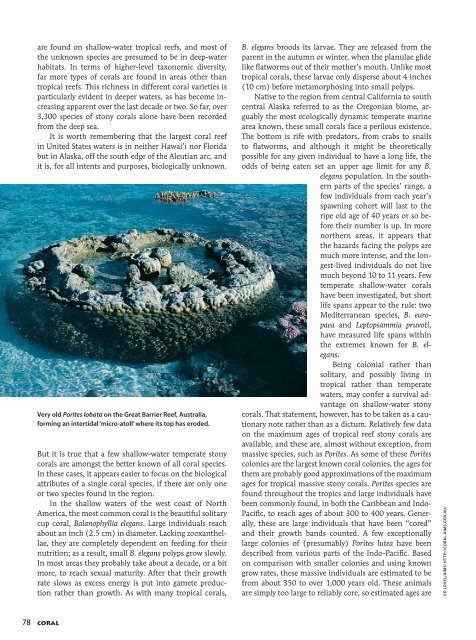Create successful ePaper yourself
Turn your PDF publications into a flip-book with our unique Google optimized e-Paper software.
are found on shallow-water tropical reefs, and most of<br />
the unknown species are presumed to be in deep-water<br />
habitats. In terms of higher-level taxonomic diversity,<br />
far more types of corals are found in areas other than<br />
tropical reefs. This richness in different coral varieties is<br />
particularly evident in deeper waters, as has become increasing<br />
apparent over the last decade or two. So far, over<br />
3,300 species of stony corals alone have been recorded<br />
from the deep sea.<br />
It is worth remembering that the largest coral reef<br />
in United States waters is in neither Hawai’i nor Florida<br />
but in Alaska, off the south edge of the Aleutian arc, and<br />
it is, for all intents and purposes, biologically unknown.<br />
Very old Porites lobata on the Great Barrier Reef, Australia,<br />
forming an intertidal ‘micro-atoll’ where its top has eroded.<br />
But it is true that a few shallow-water temperate stony<br />
corals are amongst the better known of all coral species.<br />
In these cases, it appears easier to focus on the biological<br />
attributes of a single coral species, if there are only one<br />
or two species found in the region.<br />
In the shallow waters of the west coast of North<br />
America, the most common coral is the beautiful solitary<br />
cup coral, Balanophyllia elegans. Large individuals reach<br />
about an inch (2.5 cm) in diameter. Lacking zooxanthellae,<br />
they are completely dependent on feeding for their<br />
nutrition; as a result, small B. elegans polyps grow slowly.<br />
In most areas they probably take about a decade, or a bit<br />
more, to reach sexual maturity. After that their growth<br />
rate slows as excess energy is put into gamete production<br />
rather than growth. As with many tropical corals,<br />
B. elegans broods its larvae. They are released from the<br />
parent in the autumn or winter, when the planulae glide<br />
like flatworms out of their mother’s mouth. Unlike most<br />
tropical corals, these larvae only disperse about 4 inches<br />
(10 cm) before metamorphosing into small polyps.<br />
Native to the region from central California to south<br />
central Alaska referred to as the Oregonian biome, arguably<br />
the most ecologically dynamic temperate marine<br />
area known, these small corals face a perilous existence.<br />
The bottom is rife with predators, from crabs to snails<br />
to flatworms, and although it might be theoretically<br />
possible for any given individual to have a long life, the<br />
odds of being eaten set an upper age limit for any B.<br />
elegans population. In the southern<br />
parts of the species’ range, a<br />
few individuals from each year’s<br />
spawning cohort will last to the<br />
ripe old age of 40 years or so before<br />
their number is up. In more<br />
northern areas, it appears that<br />
the hazards facing the polyps are<br />
much more intense, and the longest-lived<br />
individuals do not live<br />
much beyond 10 to 11 years. Few<br />
temperate shallow-water corals<br />
have been investigated, but short<br />
life spans appear to the rule: two<br />
Mediterranean species, B. europaea<br />
and Leptopsammia pruvoti,<br />
have measured life spans within<br />
the extremes known for B. elegans.<br />
Being colonial rather than<br />
solitary, and possibly living in<br />
tropical rather than temperate<br />
waters, may confer a survival advantage<br />
on shallow-water stony<br />
corals. That statement, however, has to be taken as a cautionary<br />
note rather than as a dictum. Relatively few data<br />
on the maximum ages of tropical reef stony corals are<br />
available, and these are, almost without exception, from<br />
massive species, such as Porites. As some of these Porites<br />
colonies are the largest known coral colonies, the ages for<br />
them are probably good approximations of the maximum<br />
ages for tropical massive stony corals. Porites species are<br />
found throughout the tropics and large individuals have<br />
been commonly found, in both the Caribbean and Indo-<br />
Pacific, to reach ages of about 300 to 400 years. Generally,<br />
these are large individuals that have been “cored”<br />
and their growth bands counted. A few exceptionally<br />
large colonies of (presumably) Porites lutea have been<br />
described from various parts of the Indo-Pacific. Based<br />
on comparison with smaller colonies and using known<br />
grow rates, these massive individuals are estimated to be<br />
from about 350 to over 1,000 years old. These animals<br />
are simply too large to reliably core, so estimated ages are<br />
ED LOVEL/AIMS: HTTP://CORAL.AIMS.GOV.AU/<br />
78 CORAL

















